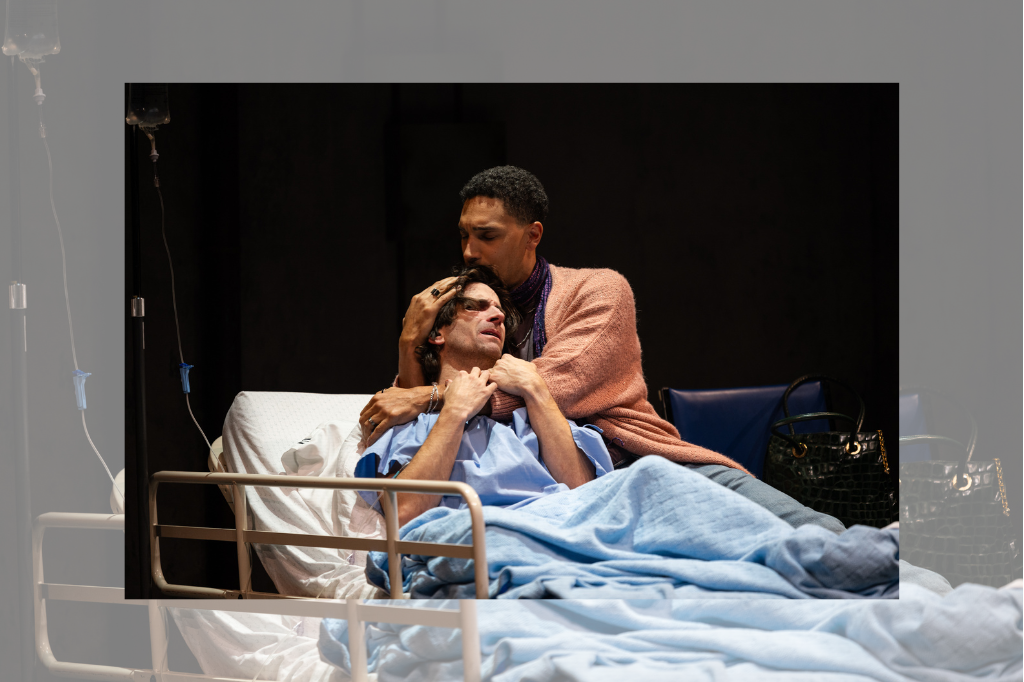REVIEW: That Theatre Company’s Angels in America struggles to take flight
Angels in America is a play of ideas. The Reagan-era New York of Tony Kushner’s two-part, seven-and-a-half-hour drama plays host to prophets, Mormons, drag queens, rabbis, travel agents, earthquakes, McCarthyism, historical dioramas brought to life, and a lawyer who’s more octopus than man. The astonishments start flowing from the opening monologue and never let up.
Disappointingly, That Theatre Company’s new production, presented in association with Buddies in Bad Times Theatre, has few ideas of its own. Despite ethereal lighting by Bonnie Beecher and a skilled cast including many Shaw Festival veterans, That Arts Group artistic director Craig Pike’s debut directorial effort fails to translate Kushner’s vibrant fantasia into consistently engaging theatrical action.
The play puts forth a complex web of interlocking plots. At its centre is the scruffy and sensitive Prior (Allister MacDonald), who, in the first of Part One: Millennium Approaches’ three acts, reveals to his neurotic boyfriend Louis (Ben Sanders) that he has AIDS. The overwhelmed Louis then meets and falls for the closeted Mormon Joe (Wade Bogert-O’Brien), who’s under the thumb of volcanic lawyer Roy Cohn (Jim Mezon), and married to Harper (Christine Horne), an agoraphobic Mormon with a Valium addiction. Also featured: an Angel (Soo Garay), Joe’s mother Hannah (Brenda Bazinet), Prior’s close friend Belize (Kaleb Alexander), and many other eccentric figures (split between the already mentioned actors).
In Part Two: Perestroika, a deteriorating Prior receives a message from the Angel. The gist: God abandoned heaven in 1906 because humanity’s propensity for global development and migration was causing tremors up there. The Angel tells Prior that heaven’s natural state will only be restored if this behaviour ends; thus, Prior’s mission is to ensure humanity returns to a state of immobility. Meanwhile, Roy, stuck in a hospital with AIDS, uses his connections to get a private supply of the hard-to-get drug AZT, despite the protests of Belize, his nurse. And as Louis learns about Joe’s ties to the Republican political machine with disgust, Hannah looks after Harper at a creepy Mormon visitors’ centre.
Theatre folk have spoken about Angels in America in near-mythological tones ever since Millennium Approaches’ 1991 San Francisco premiere. Kushner’s smart balance of the specific (AIDS in Reagan’s America) with the general (the intentionally ambiguous “Great Work”) has facilitated the play’s continued resonance. But, in my view, the work’s formal ambition is what continues to engulf: its jagged structure and soaring theatricality, combined with that ever-intimidating runtime, make for an all-consuming experience that flies in searing contrast to the foundation of instant gratification undergirding much of today’s popular media.
Pike’s production doesn’t fully commit to a specific conceptual direction. Brian Dudkiewicz’s set resembles a grimy warehouse, and sound designer John Gzowski blasts techno beats during many of the transitions, so Pike might be going for an industrial aesthetic: America as a kind of dystopian capitalist wasteland, perhaps?
If so, this potentially intriguing angle is not followed up on enough. And it isn’t mentioned in the program; instead, Pike’s director’s note implies there isn’t a concept at all: “It is quite humbling to kneel at the feet of this masterpiece,” he writes of his approach. Though there might be use in kneeling at the feet of an unknown play, this strikes me as a rather uninteresting way of thinking about a work that’s already canonical. The question of why we need a new production of Angels in America here and now is one that needs to be rigorously considered.
But a thin concept can still produce exciting results with the right execution — many Toronto shows pull off that trick every year. Even within this context, however, the production struggles. Angels in America needs to be carefully paced, and this version isn’t. The issue is one of stakes — although the play’s characters are in surreal, life-and-death situations, it doesn’t always feel like it here — but also of blocking. Pike and Dudkiewicz have set up the Buddies Chamber space in a wide alley configuration. Yet Pike rarely uses this width to its full advantage, rather tending to squeeze scenes into their own small section of the stage. This means the actors are often very close together, which is a shame: distance is a key ingredient in the staging of conflict. (The alley setup produces other dramatic concerns, like scenes being closed off to large portions of the audience.)
Though as a unit the performances don’t feel wholly cohesive, on an individual level most work well enough. Sanders is a poised Louis; he navigates the character’s large blocks of text with audacity and focus. Bogert-O’Brien, meanwhile, is a sensitive, understated Joe — there’s lots going on inside, which nicely contrasts the outward energy produced by Horne’s hyper-specific physicality.
But the highlight for me is Beecher’s hazy, daringly theatrical lighting. She defines interweaving locations with grace, and doesn’t shy away from shadows when appropriate — when Joe drunkenly phones Hannah to come out as gay, for instance, he’s lit by what seems to be just one beam of light; as it hits him diagonally from above, his face remains shrouded in darkness: a visual representation of his shame. Despite this Angels in America’s other issues, being in Beecher’s expert hands for two long evenings is a pleasure.
Gzowski’s sound design doesn’t quite match the lighting in subtlety. Though he gives climactic moments the needed punch, he and Pike make a bizarre choice: for the vast majority of Perestroika’s four-hour runtime, an ominous rumble can be heard in the background. It even continues during intermission. I don’t see why this is necessary — couldn’t the actors be trusted to conjure more of the desired tone on their own?
Look, it’s clear an immense amount of work went into That Theatre Company’s Angels in America. And hearing professional actors speak Kushner’s text isn’t likely to get old any time soon. But considering how dangerous the play still feels on the page, the bottled-up nature of Pike’s production left me disheartened.
Angels in America runs at Buddies in Bad Times Theatre until December 17. Tickets are available here.
Intermission reviews are independent and unrelated to Intermission’s partnered content. Learn more about Intermission’s partnership model here.















Comments